List of stews
This is a list of notable stews. A stew is a combination of solid food ingredients that have been cooked in liquid and served in the resultant gravy. Ingredients in a stew can include any combination of vegetables (such as carrots, potatoes, beans, onions, peppers, tomatoes, etc.), plus meat, especially tougher meats suitable for slow-cooking, such as beef. Poultry, pork, lamb or mutton, sausages, and seafood are also used.
Stews
| Name | Image | Origin | Description and distinctive ingredients |
|---|---|---|---|
| Ají de gallina | 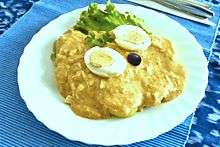 |
Peru | Peruvian chicken stew |
| Alicot | France | Stew made with poultry giblets and possibly the head, feet and wing tips. | |
| Andrajos | .jpg) |
Spain (Jaén) | Stew of tomatoes, onions, garlic, red pepper and rabbit, thickened with cake flour. |
| Asam pedas | 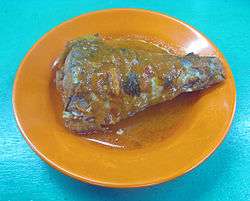 |
Indonesia Malaysia |
Sour and spicy stew dish made of seafood cooked in tamarind fruit juice, chili and other spices. |
| Balbacua | Philippines | Beef stew made from beef and collagen-rich parts of beef stewed for four to six hours in various spices. | |
| Bamia | Egypt | Egyptian stew prepared with lamb and okra as primary ingredients. | |
| Beef bourguignon |  |
France (Burgundy) | Stew made of beef braised in red wine (traditionally red Burgundy)[1] and beef broth, generally flavoured with garlic, onions and a bouquet garni, with pearl onions and mushrooms. |
| Beef Stroganoff | 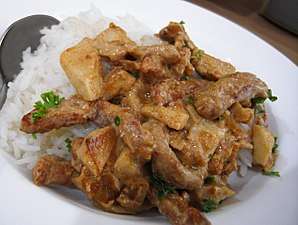 |
Russia | Beef Stroganoff or beef Stroganov (Russian: бефстроганов befstróganov) is a Russian dish of sautéed pieces of beef served in a sauce with smetana (sour cream). |
| Bicol Express | 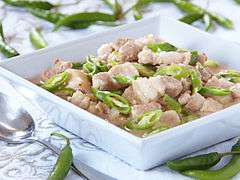 |
Philippines | Stew made from long chillies, coconut milk, shrimp paste or stockfish, onions, pork, and garlic. |
| Bigos | .jpg) |
Poland Ukraine Lithuania |
Stew that features white cabbage, sauerkraut, various cuts of meat and sausages, often whole or puréed tomatoes, honey and mushrooms as ingredients. |
| Birnen, Bohnen und Speck | 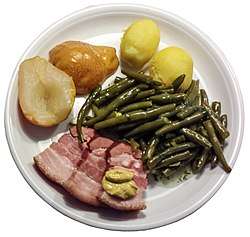 |
Germany | Typical dish in which pears, beans and bacon are cooked together. |
| Birria | 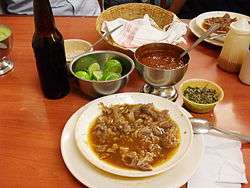 |
Mexico | Spicy meat stew made of pork, goat, lamb, or mutton that is traditionally served on holidays, such as Christmas. |
| Blanquette de veau | 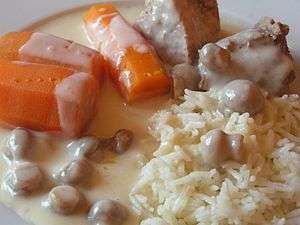 |
France | Bright veal ragout with mirepoix. |
| Booyah | 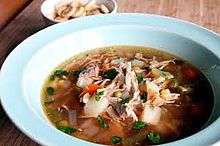 |
United States (Upper Midwestern) | Thick stew popular in the Upper Midwestern United States with meat and vegetables. Often prepared communally in large kettles, with several different meats. |
| Bosnian Pot | 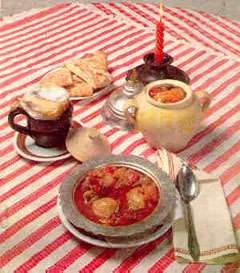 |
Bosnia and Herzegovina | Typical Bosnian dish with ingredients: beef, lamb, cabbage, potatoes, tomatoes, carrots, parsley, garlic, and peppercorns (whole, not ground). |
| Bouillabaisse | 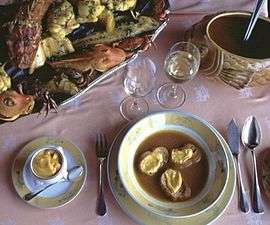 |
France (Marseille) | Bony fish and seafood stew with vegetables and Provençal herbs and spices. The name refers to a "simmering boil", the temperature of cooking the stew. |
| Brongkos | 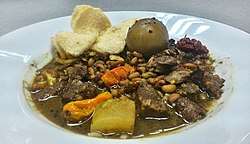 |
Indonesia (Yogyakarta and Central Java) | Meat (beef or mutton) with beans (black-eyed peas or kidney beans) stew, with boiled egg and spicy soup made of Pangium edule, coconut milk and other spices. |
| Brudet | Croatia | Fish stew that is usually eaten with polenta. | |
| Brunswick stew | 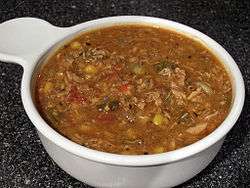 |
United States (Southern) | Tomato-based stew containing various types of lima beans or butter beans, corn, okra, and other vegetables, and one or more types of meat. Most recipes claiming authenticity call for squirrel or rabbit meat, but chicken, pork, and beef are also common ingredients. |
| Buseca | Italy | Italian stew common in Uruguay and Argentina, similar to callos, it is made of finely chopped mondongo (beef tripe), potatoes and legumes such as lentils or chickpeas. | |
| Buddha Jumps Over the Wall | 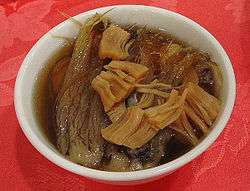 |
China | Cantonese variation on shark fin soup. |
| Buğu kebabı | Turkey | Turkish lamb and vegetable stew with a kebab name. | |
| Burgoo |  |
United States (Midwestern and Southern) | Traditionally made with wild game, this spicy thick stew is similar to Irish or Mulligan stew, often served with cornbread or corn muffins. Often prepared communally, with several different meats. |
| Cabbage stew | 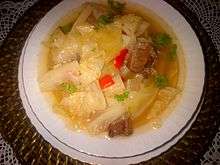 |
Central Europe | Prepared using cabbage as a main ingredient. Pictured is kapuska. |
| Cacciucco | 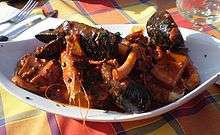 |
Italy | Fish stew with several different types of fish and shellfish cooked in wine, tomatoes, and chili pepper. |
| Cachupa |  |
Cape Verde | Slow cooked stew of corn (hominy), beans, and fish or meat (sausage, beef, goat or chicken). |
| Caldeirada | 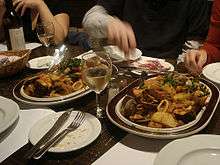 |
Portugal | Stew consisting of a large variety of fish, and sometimes shellfish, with potatoes, tomatoes and onions. |
| Caldereta de cordero | Spain | Lamb or mutton stew. | |
| Caldo avá | Paraguay | Stew made of beef tripes, chitterlings, heart and matambre. | |
| Caldo gallego | 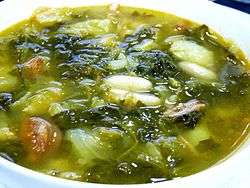 |
Spain | Stew made with fatty pork, white beans, and greens (cabbage or spring greens). Literally means "Galician stew". |
| Callaloo | 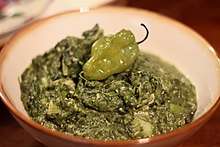 |
Caribbean West Africa |
Caribbean dish made of leaf vegetables, amaranth, capsicum and taro. |
| Callos | 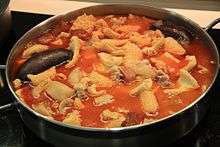 |
Spain | Stew common across Spain, and is considered traditional to Madrid. In Madrid, it is referred to as callos a la madrileña. Contains beef tripe and chickpeas, blood sausage and bell peppers. Chorizo sausage may also be used. |
| Caparrones | Spain (La Rioja) | Stew made of caparrón (a variety of red kidney beans) and a spicy chorizo sausage. | |
| Capra e fagioli | Italy (Liguria) | Stew made of goat meat, white wine and white Pigna beans | |
| Carbonade flamande | Belgium | Traditional Belgian sweet-sour beef and onion stew made with beer, and seasoned with thyme and bay leaf. | |
| Carne mechada | .jpg) |
Colombia Chile Venezuela[2] |
Latin American beef stew. |
| Cassoulet | 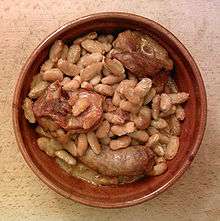 |
France (Languedoc) | French dish that consists of slow-cooked meat (typically pork sausages, pork, goose, duck, and sometimes mutton) with white haricot beans. |
| Cawl | 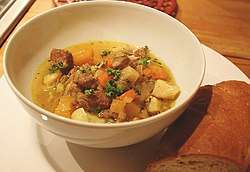 |
Wales | Lamb stew (beef or hock in Pembrokeshire) which includes vegetables, such as leeks and potatoes, as well as carrots, celery, onion, parsnip, swede, and turnip. |
| Chairo | Bolivia | Meat and vegetable stew with potato starch (chuños), onions, carrots, potatoes, white corn, beef and wheat kernels. | |
| Chakapuli |  |
Georgia | Popular stew with lamb chops or veal, onions, tarragon leaves, cherry plums or tkemali (cherry plum sauce), dry white wine, mixed fresh herbs (parsley, mint, dill, coriander), garlic and salt. |
| Chapea | Dominican Republic | Traditional dish from the countryside that consists of cooked red beans with longaniza (Dominican sausage), rice, ripe plantain and mashed squash, which is used as a thickener. | |
| Chicken mull | United States (Southern) | Traditional dish from North Carolina and Georgia. It is a type of stew consisting of parboiled whole chicken in a cream or milk based broth with butter, seasoned with salt, pepper and other ingredients. Traditionally, the stew is served in the late fall and winter months. Often prepared communally. | |
| Chili con carne | 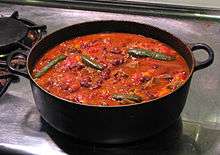 |
United States (Texas) | A spicy stew that traditionally features chopped or ground beef, peppers and other ingredients. |
| Cholent |  |
Jewish | Slowly simmered Jewish stew that cooks overnight and is traditionally served on Shabbat. Main ingredients are meat, potatoes, beans, and barley; some recipes (Sephardi) include rice and substitute chicken for beef. |
| Chupe Andino | Andes | Refers to various stews and soups that are prepared in Andes Mountains region of South America. | |
| Ciambotta | 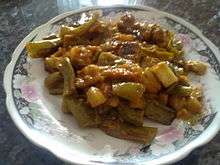 |
Italy | Based on vegetables, but may have other ingredients, such as meat or fish. The vegetable choices are usually potatoes, eggplant, tomatoes, sweet peppers, chili, onion and herbs. |
| Cincinnati chili | 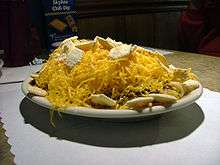 |
United States (Ohio) | Mediterranean-spiced meat sauce used as a topping for spaghetti or hot dogs. |
| Cioppino | 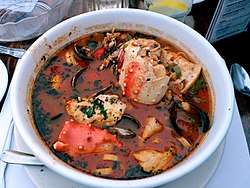 |
United States (San Francisco) | Italian-American fish stew that is traditionally made from the catch of the day, which in the dish's place of origin is typically a combination of Dungeness crab, clams, shrimp, scallops, squid, mussels and fish. The seafood is then combined with fresh tomatoes in a wine sauce, and served with toasted bread, either sourdough or baguette. |
| Cocido lebaniego |  |
Spain (Cantabria) | Stew whose essential ingredients include chickpeas, potatoes and collard greens. The rest of the elements are compangu, meat from the pig slaughter, such as bacon (tocino), black pudding (morcilla), chorizo and ham. Other additional ingredients are beef, especially cecina and bones, and a stuffing made of bread flour, egg and parsley. |
| Cocido madrileño | 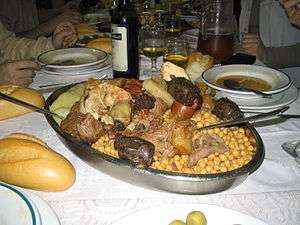 |
Spain (Madrid) | Stew whose main ingredient is the chickpea or garbanzo bean, preferably of its larger variety (also known as kabuli). Vegetables are added: potatoes mainly, but also cabbage, carrots, and turnips. In some cases, green beans, mangold, or cardoon are also added. |
| Cocido montañés | Spain (Cantabria) | Highlander stew is made with two vegetal ingredients, dried large white beans and collard greens (berza). The rest of the elements of this recipe are known as compangu, meat ingredients from the pig slaughter: bacon (tocino), pork ribs (costilla), black pudding (morcilla) with rice, and chorizo. | |
| Compote | Game stew made for example from rabbit, partridge, or pigeon. | ||
| Corn stew |  |
Stew prepared with corn (maize) as a primary ingredient. | |
| Coq au vin | 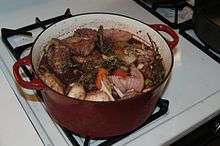 |
France | French braise of chicken cooked with wine, lardons, mushrooms, and optionally garlic. |
| Cotriade | France (Brittany) | Breton-style stew made with potatoes and many kinds of fish, but without shellfish. | |
| Cozido/Cocido | Portugal Spain |
Stew made with different meats and vegetables; numerous regional variations exist throughout Portugal and Spain. | |
| Daube | 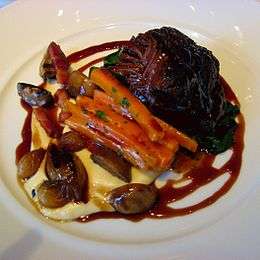 |
France (Provence) | Classic Provençal stew made with inexpensive beef braised in wine, vegetables, garlic, and herbes de Provence, and traditionally cooked in a daubière, a braising pan. |
| Dillegrout | England | Chicken pottage made with almond milk, sugar, and spices traditionally presented at coronations of English monarchs by the lord of the manor of Addington.[3] | |
| Dimlama | .jpg) |
Uzbekistan | Stew made with various combinations of meat, potatoes, onions, vegetables, and sometimes fruits. |
| Dinuguan | 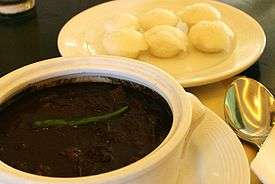 |
Philippines | Filipino savory stew of meat and/or offal (typically lungs, kidneys, intestines, ears, heart and snout) simmered in a rich, spicy dark gravy of pig blood, garlic, chili (most often siling mahaba), and vinegar. |
| Drokpa Katsa | Tibet | Stewed tripe, with curry, fennel, monosodium glutamate, and salt. | |
| Escudella i carn d'olla | 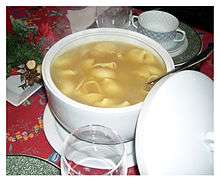 |
Spain (Catalonia) | Stew that contains a pilota (a very big meatball spiced with garlic and parsley); it also contains vegetables, such as celery, cabbage, carrots, etc. depending on the season. Additionally, bones, sausages called botifarras, and other types of meat can be used. |
| Étouffée |  |
United States (Louisiana) | Seafood dish of the Creole cuisine of Louisiana that is usually served with shellfish over rice. Literally means "smothered" in French. |
| Fabada Asturiana | 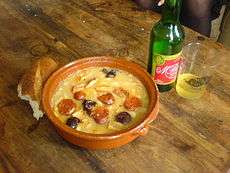 |
Spain (Asturias) | Fabada is made with dried large white beans (fabes de la Granja, soaked overnight before use), shoulder of pork (Lacón Gallego) or bacon (tocino), black pudding (morcilla), chorizo, and often saffron (azafrán). Some recipes also call for longaniza. |
| Fabes con almejas |  |
Spain (Asturias) | Clam stew that calls for small clams, fava beans, onions, garlic, salt, saffron, bay leaves, olive oil, parsley, bread crumbs and sometimes sweet paprika. |
| Fahsa | 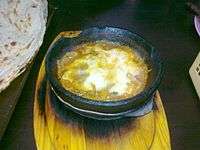 |
Yemen | Stew made of lamb cutlets with lamb broth. Spices and holba (fenugreek) are added after cooking. |
| Fårikål | 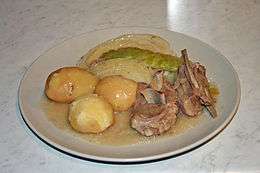 |
Norway | Traditional dish, consisting of pieces of mutton with bone, cabbage, whole black pepper and a little wheat flour, cooked for several hours in a casserole, traditionally served with potatoes boiled in their skins. Literally means "mutton in cabbage". |
| Fasole cu cârnaţi |  |
Romania | Dish consisting of baked beans, sausages and/or smoked ham. |
| Feijoada | 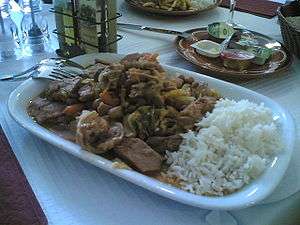 |
Brazil Portugal |
Stew of beans with beef or pork, and may include other vegetables. |
| Fesenjān | 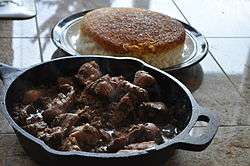 |
Iran | Thick, tart stew made from pomegranate juice and ground walnuts; traditionally made with poultry, but variants using balls of ground meat, ghormeh cut lamb, fish, or no meat at all are not unusual. |
| Flaki | Poland | Meat stew with common ingredients, including beef tripe, beef, bay leaf, parsley, carrots, beef broth, and spices to taste, including salt, black pepper, nutmeg, sweet paprika, and marjoram. | |
| Főzelék | 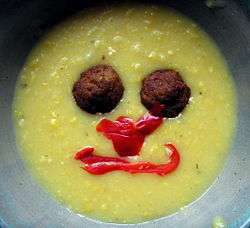 |
Hungary | Very thick vegetable soup, so it may be considered a stew. Sometimes served with meatballs and often eaten as a side dish. |
| Fricot | Canada (Acadia) | Consists of potatoes, onions, and whatever meat was available, cooked in a stew and topped with dumplings. The common meats used are chicken (fricot au poulet), clams (fricot aux coques), rabbit (fricot au lapin des bois), beef, or pork. | |
| Gaisburger Marsch |  |
Germany (Swabia) | Swabian dish made from meat with cooked potatoes and spätzle. |
| Galinhada |  |
Brazil | Stew of rice and chicken. |
| Garbure | 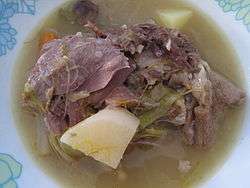 |
France (Gascony) | Stew of ham with cabbage and other vegetables, usually with cheese and stale bread added. |
| Ghapama | Armenia | Sweet pumpkin stew, traditionally cooked in the pumpkin shell; does not contain meat. | |
| Ghormeh sabzi | Iran | Dish that consists of a mixture of sautéed herbs, consisting mainly of parsley, leek, and a smaller amount of fenugreek leaves, where this is usually the dry herb of the mix. | |
| Goat water | 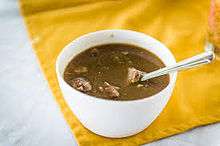 |
Montserrat | A national dish of Montserrat prepared with goat meat and vegetables. |
| Goulash | 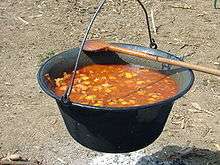 |
Hungary | Soup or stew of meat, noodles and vegetables (especially potato), seasoned with paprika and other spices. |
| Guatitas | Chile Ecuador |
Stew whose main ingredient is pieces of tripe. | |
| Gumbo |  |
United States (Louisiana) | Stew or soup that consists primarily of a strongly-flavored stock, with meat or shellfish, a thickener, and the vegetable "holy trinity" of celery, bell peppers, and onions. |
| Güveç |  |
Turkey | Vegetable and meat stew made with mutton or veal and common to Balkan countries. |
| Guyana Pepperpot | .jpg) |
Guyana | Stewed meat dish, strongly flavored with cinnamon, hot chili peppers, and cassareep (a special sauce made from the cassava root). Beef, pork, and mutton are the most popular meats used, though chicken is also used. |
| Hachee | 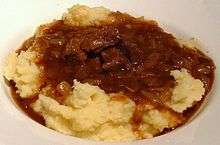 |
Netherlands | Traditional Dutch stew based on diced meat, fish or poultry, and vegetables. |
| Hasenpfeffer |  |
Germany | Traditional German stew made from marinated rabbit or hare, cut into stewing-meat sized pieces and braised with onions and wine, in a marinade thickened with the animal's blood. |
| Hochepot | 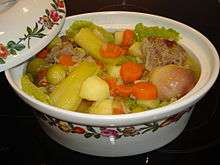 |
France | Flemish stew made with oxtail, shoulder of mutton, salted bacon, and vegetables. |
| Hoosh | United States | Thick stew made from pemmican (a mix of dried meat, fat, and cereal) or other meat, thickener such as ground biscuits, and water. Used on expeditions to frozen polar regions. | |
| Hot pot | China Mongolia |
Stew made with a variety of raw meats, seafood, vegetables, noodles, dumplings, etc., all cooked at the table in a simmering hot pot of broth. | |
| Irish stew |  |
Ireland | Traditional stew made from lamb or mutton, as well as potatoes, carrots, onions, and parsley. |
| Islim or patlıcan kebabı | 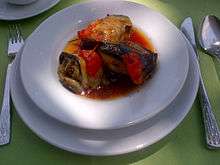 |
Turkey | Traditional stew made from veal or mutton and eggplants, also having tomatoes and green peppers. |
| Istrian stew | Croatia | Stew whose main ingredients are beans, sauerkraut, potatoes, bacon, and spare ribs; the main seasoning is garlic. | |
| Kadhi |  |
Indian subcontinent | Spicy stew whose thick gravy is based on chickpea flour (called besan in Hindi) and contains vegetable fritters called pakoras, to which sour yoghurt is added to give it a little sour taste. |
| Kaldereta |  |
Philippines | Dish whose common ingredients are goat shoulders with tomato paste and liver spread. |
| Kamounia | Sudan, Egypt, and Tunisia | Beef and liver stew prepared with cumin | |
| Kapuska |  |
Turkey | Cabbage and veal stew. |
| Kare-kare | 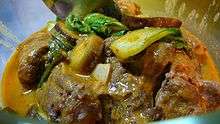 |
Philippines | Popular stew made from a peanut-based sauce with a variety of vegetables, stewed oxtail, beef, and occasionally offal or tripe. Meat variants may include goat meat or (rarely) chicken. |
| Karelian hot pot |  |
Finland | Stew that features a combination of pork and beef, but lamb can also be used. The hot pot is usually seasoned with black peppercorns and salt. Other seasonings such as allspice and bay leaf may be used too. Common vegetables such as carrot, onion, and root vegetables are acceptable additions to the stew. |
| Kig ha farz | 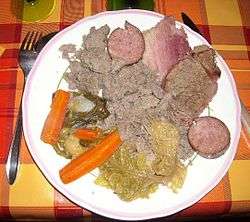 |
France (Brittany) | Stew consisting of various meats (hock, beef and lamb) simmered in a broth with carrots, potatoes, cabbage and a large buckwheat flour based dumpling. Literally means "meat and stuffing" in Breton. Known mainly in Finisterre. |
| Kuru fasulye |  |
Turkey | Stew consisting of dry beans, generally with meat (veal or mutton) and pastırma or sucuk in its broth, with tomato paste. |
| Lancashire hotpot | 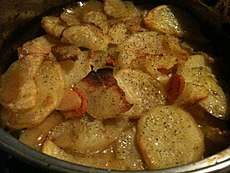 |
United Kingdom (England) | Dish made traditionally from lamb or mutton, and onion topped with sliced potatoes, left to bake in the oven all day in a heavy pot and on a low heat. |
| Läskisoosi | Finland | Pork chops grilled in butter with onions and flour, stirred in water with salt and pepper. | |
| Lecsó | Hungary Czech Republic |
Thick vegetable stew which features peppers, tomato, onion, lard, salt, sugar and ground paprika as a base recipe. | |
| Lobster stew | 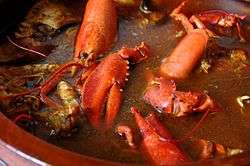 |
Spain (Menorca) | Stew made from lobster, which is added to a sofrito with onion, tomato, garlic and parsley; then boiled, and is eaten with thin slices of bread. |
| Locro |  |
Peru Ecuador Bolivia Chile |
Hearty thick stew whose main ingredients are corn, some form of meat (usually beef, but sometimes beef jerky or chorizo), and vegetables. Other ingredients vary widely, and typically include onion, beans, squash or pumpkin. |
| Lunggoi Katsa | Tibet | Dish consisting of stewed sheep's head, with curry, fennel, monosodium glutamate, and salt. | |
| Maafe | West Africa | Stew that is made from lamb, beef, or chicken, cooked with a sauce based on tomatoes and groundnuts (peanuts). | |
| Maconochie | United Kingdom (England) | Stew of sliced turnips and carrots in a thin soup that was especially made by the "Maconochie Company" for soldiers during World War I | |
| Mechado | Philippines | Stew of Spanish origin, traditionally made with larded beef, but now also made with leaner cuts. Marinating in soy sauce and calamansi juice give it a Filipino flavor. | |
| Mjave lobio |  |
Georgia | Dish of stewed beans, tomatoes and onion. |
| Moambe | .jpg) |
Central Africa | Dish prepared with a sauce usually made from the pericarp (not the seeds) of palm nuts, the fruit of the African oil palm. |
| Mocotó | Brazil Portugal |
Dish made from cow's feet, stewed with beans and vegetables. | |
| Molagoottal | India | South Indian stew with coconut and lentils as a base. | |
| Moqueca | Brazil | Stew based on salt water fish stew, tomatoes, onions, garlic and coriander. | |
| Mulligan stew | United States | Dish similar to Irish stew, Brunswick stew, or burgoo, as improvised by American hobos from available or scavenged ingredients, such as squirrel or opossum. | |
| Navarin | 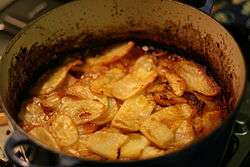 |
France | French ragoût (stew) of lamb or mutton. Often, vegetables are added. |
| Ndolé | Cameroon | National dish of Cameroon, a stew of nuts, ndoleh (bitter leaves indigenous to West Africa), and fish or ground beef. | |
| Nikujaga | 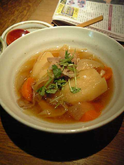 |
Japan | Japanese dish of meat, potatoes and onion stewed in sweetened soy sauce, sometimes with ito konnyaku and vegetables. |
| Oil Down | Grenada | Stew made of breadfruit, salted meat, chicken, dumplings, callaloo, and other vegetables, all stewed in coconut milk, herbs, and spices. National dish of Grenada, but also popular in Trinidad and Tobago (with hot peppers and no dumplings.) | |
| Olla podrida |  |
Spain | Spanish stew made from pork and beans and an inconsistent, wide variety of other meats and vegetables, often including chickpeas, depending on the recipe used. |
| Ollada | Spain (Valencia) | Stew based on boiling vegetables and meat in a casserole. | |
| Ostrich stew | South Africa | Ostrich stew is a stew prepared using ostrich meat as a primary ingredient. Additional ingredients can include vegetables such as onion, celery and carrot, tomatoes, soup stock and wine. | |
| Ostropel | Romania | Stew that is primarily made from chicken mixed with a thick tomato sauce. | |
| Oyster stew | 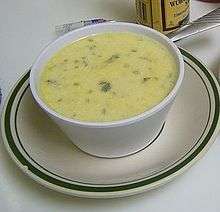 |
United States | Stew made from oysters with milk and cream |
| Paila marina | Chile | Typical stew that is usually made of a shellfish stock containing different kinds of cooked shellfish and fish. These are complemented with a variety of herbs and spices such as garlic, cilantro, and onion. | |
| Palaver sauce | .jpg) |
West Africa | Stew popular in Western Africa that has many regional varieties and may contain beef, fish, shrimp, pepitas, cassava, taro (cocoyam) leaves, and palm oil. It is served with boiled rice, potatoes, garri, fufu, or yams. |
| Paomo | 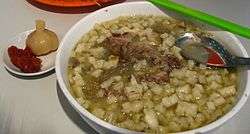 |
China | Stew of chopped-up baked unleavened bread cooked in lamb broth and served with lamb meat. It is often eaten with pickled garlic and chilli sauce. |
| Pasulj (also known as Grah) | 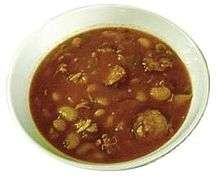 |
Serbia, Montenegro, Bosnia, Croatia and Slovenia | Bean soup made of usually white, cranberry or pinto beans. It is normally prepared with meat, particularly smoked meat such as smoked bacon, sausage, and ham hock, and is a typical winter dish. |
| Philadelphia Pepper Pot | United States (Pennsylvania) | Thick stew of beef tripe, vegetables and other seasonings; originates in the cuisine of the Pennsylvania Dutch. | |
| Pichelsteiner |  |
Germany | German stew that consists of several types of meats and vegetables. Common ingredients are beef, pork and mutton, as well as potatoes, carrots and leek. |
| Pinangat | 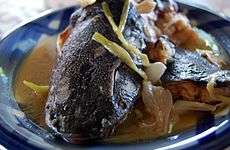 |
Philippines | Filipino stew made of taro leaves, chilli, meat and coconut milk wrapped in gabi leaves and tied securely with coconut leaf. |
| Piperade | 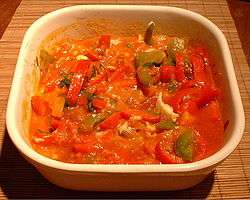 |
Spain (Basque country) | Typical Basque dish prepared with onion, green peppers, and tomatoes sautéed and flavored with red Espelette pepper.[4] |
| Pisto |  |
Spain (Murcia) | Stew made of tomatoes, onions, eggplant or courgettes, green and red peppers and olive oil. |
| Pörkölt | 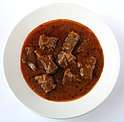 |
Hungary | Hungarian stew that consists of meat, paprika, and sometimes vegetables, but no potatoes. It should not be confused with goulash, which does always contain potatoes and is more like a soup. |
| Pot-au-feu |  |
France | French beef stew. Other ingredients may differ from region to region, but commonly various kinds of vegetables are included, such as carrots, turnips, leeks, celery and onions. |
| Potjiekos | 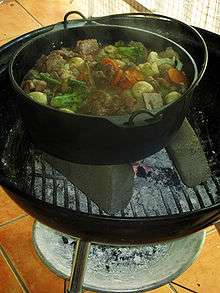 |
South Africa | South African stew that is usually prepared outdoors. The recipe commonly contains meat, vegetables, starches like rice or potatoes, all slow-cooked with Dutch-Malay spices, the distinctive spicing of South Africa's early culinary melting pot. Other common ingredients include fruits and flour-based products like pasta. |
| Pottage |  |
United Kingdom | Thick soup or stew made by boiling vegetables, grains, and, if available, meat or fish. Pottage commonly consisted of various ingredients easily available to serfs and peasants, and could be kept over the fire for a period of days, during which time some of it was eaten and more ingredients added. The result was a dish that was slowly but constantly evolving, a "perpetual stew". |
| Pozole | 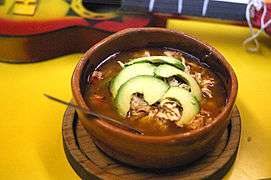 |
Mexico | Mexican stew with ritual significance made from maize with meat, usually pork, chicken, turkey, or pork rinds, with chili peppers, and other seasonings and garnishes. Vegetarian and vegan versions also exist. |
| Puchero |  |
South America Spain |
Stew whose ingredients may vary greatly according to region. Its equivalent may be the Spanish cocido. |
| Qoiri | Tibet | Stew of mutton chops, made with flour, shredded wheat, chilli, dry curd cheese, water and salt. | |
| Rabbit stew | 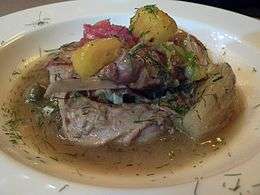 |
Stew prepared using rabbit or hare as a main ingredient. | |
| Ragout |  |
France | Refers to a main-dish stew. Ragouts may be prepared with or without meat, a wide variety of vegetables may be incorporated, and they may be more or less heavily spiced and seasoned. Pictured is ragout with lentils. |
| Ratatouille |  |
France (Provence) | Vegetable stew from the Provence that consists mainly of tomatoes with garlic, onions, courgettes (zucchini), aubergine (eggplant), poivron (bell peppers), marjoram and basil, or bay leaf and thyme, or a mix of green herbs, such as herbes de Provence. |
| Red cooked pork |  |
China | Braised stew made with soy sauce, Chinese rice wine, caramelized sugar, and spices. Usually made with pork, but other meats, such as beef or chicken are also cooked in this style. |
| Rössypottu | Finland | Stew made using potatoes (pottu, peruna), some pork and the main ingredient, so-called "rössy" (i.e. blood pudding made of blood, beer, rye flour and some spices). | |
| Rogan Josh | 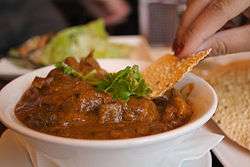 |
India | Aromatic lamb stew native to the Indian subcontinent, which is one of the signature recipes of Kashmiri cuisine. Rogan josh consists of braised lamb chunks cooked with a gravy based on browned onions or shallots, yogurt, garlic, ginger and aromatic spices (cloves, bay leaves, cardamom and cinnamon). |
| Rubaboo | North America | Basic stew or porridge consumed by coureurs des bois and voyageurs (fur traders), as well as Métis people from North America, traditionally made of peas or corn (or both) with grease (bear or pork) and a thickening agent (bread or flour). | |
| Sagamite | North America | Native-American stew made from hominy or Indian corn. Additional ingredients may include vegetables, wild rice, brown sugar, animal fat, beans, smoked fish or animal brains. | |
| Saksang | 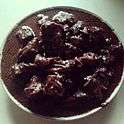 |
Indonesia | Spicy stew made from minced pork or dog meat (or more rarely, water buffalo meat) stewed in blood, coconut milk, and spices. |
| Saltah |  |
Yemen | Considered the national dish of Yemen, the base is a brown meat stew called maraq, with fenugreek froth and sahawiq or sahowqa (a mixture of chillies, tomatoes, garlic, and herbs ground into a salsa). Common additions are rice, potatoes, scrambled eggs, and vegetables. |
| Scouse | 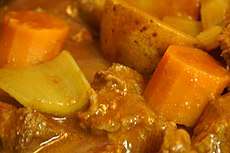 |
United Kingdom (England) | Variation of labskaus; a type of meat or beef stew. |
| Seco | _from_Lima_Peruvian_at_Off_the_Grid-_Fort_Mason_Center_(7423438016).jpg) |
Ecuador | Stewed meat. |
| Sekba |  |
Indonesia | Chinese Indonesian pork offals stewed in mild soy sauce-based soup. The stew tastes mildly sweet and salty, made from soy sauce, garlic, and Chinese herbs. |
| Semur |  |
Indonesia | Type of meat stew that is processed in thick brown gravy. The main material used in semur gravy is shallots, onions, garlic, kecap manis (sweet soy sauce), nutmeg, and cloves. |
| Shiro | 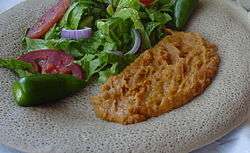 |
Eritrea | Homogeneous stew whose primary ingredient is powdered chickpeas or broad bean meal. |
| Sinigang | 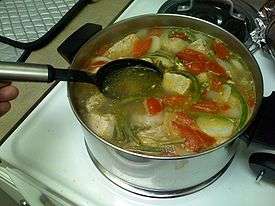 |
Philippines | Filipino soup or stew characterized by its sour flavor most often associated with tamarind (sampalok). |
| Skirts and kidneys | Ireland | Irish stew made from pork and pork kidneys. | |
| Sonofabitch stew | United States (Western) | Cowboy dish consisting of whatever is on hand. Most recipes call for meat and offal from a calf. | |
| Stew peas | Jamaica | Jamaican stew prepared using coconut milk, gungo peas (pigeon peas) or red peas (kidney beans), uncured meats and salted meats such as pork and beef. Can also include onion, garlic, scallions, pig tail, herbs, and spices. | |
| Sulu köfte |  |
Turkey | Soup-like stew with köfte meatballs in the dish. |
| Tajine |  |
North Africa | Berber dish from North Africa, that is named after the special earthenware pot in which it is cooked. It includes different ingredients according to region, but commonly several kinds of vegetables, meats and spices |
| Tas kebap | 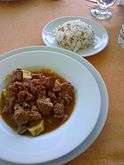 |
Turkey | Veal or mutton stew with potatoes |
| Tatws Pum Munud | Wales | Traditional Welsh stew, made with smoked bacon, stock, potatoes and other vegetables. | |
| Tharid |  |
Arab world | Dish made from pieces of bread in a vegetable or meat broth. Pictured is lamb tharid. |
| Tocană | Romania | Prepared with tomato, garlic and sweet paprika, it is traditionally consumed with a cornmeal mush called mămăligă. | |
| Tomato bredie | .jpg) |
South Africa | South African stew with Dutch origin that usually features mutton, which is cooked for a very long time, and includes cinnamon, cardamom, ginger, cloves, and chili as seasonings. |
| Tombet | Spain (Mallorca) | Traditional vegetable stew that contains layers of sliced potatoes, aubergines and red bell peppers previously fried in olive oil. The aubergines and red peppers should not be peeled. The whole is topped with tomato fried with garlic and parsley, and presented in a way that it looks like a pie without a crust. | |
| Tuna pot | Spain (Basque country) | Fish stew that was eaten on tuna fishing boats in the Cantabrian Sea; a beautiful and simple dish with potatoes, onions, pimientos, and tomatoes. | |
| Wat (food) | 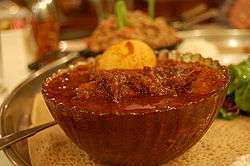 |
Ethiopia Eritrea |
Stew or curry which may be prepared with meat (such as chicken, beef, or lamb) or a variety of vegetables, with spice mixtures, such as berbere and niter kibbeh (a seasoned clarified butter). |
| Waterblommetjiebredie | South Africa | Meat, typically lamb, stewed together with waterblommetjies (Aponogeton distachyos flowers, commonly known as Cape pondweed, Cape hawthorn or Cape asparagus). Literally means "small water flower stew" in Afrikaans. | |
| Waterzooi | .jpg) |
Belgium (Flanders) | Stew made of fish or chicken, vegetables (carrots, leeks, and potatoes), herbs, eggs, cream, and butter. |
| Zoervleis | Limburg region, Belgium and the Netherlands | Traditional dish similar to German sauerbraten which features meat (normally horse meat) that was marinated in vinegar or apple cider. Contrary to what one would expect, it is sweet, as it is served with gingerbread. |
gollark: Modern wired display connectors need at least gigabytes per second. The latest version of DisplayPort goes up to 80Gbps...
gollark: Here in the UK something like 30Mbps is the common available internet connection speed outside of cities, which means a lot of compression and/or low framerate and/or resolution.
gollark: I think bandwidth might actually be more of an issue because video data is big.
gollark: On the "fibre" connection at home (VDSL to a nearby box advertised as fibre because BT) I get something like 25ms latency to Google DNS, which is less than two frames at 60Hz, so not that bad.
gollark: I think 5G is overhyped horribly anyway. LTE/4G is pretty fast anyway, the main limit for end users is data caps.
See also
- Fish stew – includes a list of many fish stews
- List of Azerbaijani soups and stews
- List of fish and seafood soups
- List of Japanese soups and stews
- List of soups
- List of Spanish soups and stews
References
- "Definition of boeuf bourguignon". Oxford University Press. Retrieved 2013-04-18.
- "Archived copy". Archived from the original on 2008-05-17. Retrieved 2008-03-23.CS1 maint: archived copy as title (link)
- Clarkson, Janet (2010). Soup : a global history. London: Reaktion. pp. 113–114. ISBN 978-1-86189-774-9. OCLC 642290114.
- Larousse Gastronomique (1998). Paris: Larousse-Bordas. p. 804. ISBN 2-03-507300-6
This article is issued from Wikipedia. The text is licensed under Creative Commons - Attribution - Sharealike. Additional terms may apply for the media files.
.jpg)